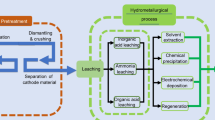Anode pastes are widely used in the production of ferroalloys and primary aluminum and in other processes in the metal and chemical industries. In consideration that their manufacturing involves dosing and mixing, the properties and performance of the commercial product are determined by the type of initial charge components and their ratio.
This study analyzed the composition of the initial charge mixtures of two anode pastes. At the initial stage, the solid carbon filler was separated from the pitch binder. The filler separated was classified by the components based on the difference in their physical properties and then divided into size classes. A comprehensive thermal analysis of the initial samples and the filler fractions was performed to evaluate the thermal transformations in the samples and to determine the filler–binder ratio in the charge. The extraction results of individual pitch fractions in the corresponding solvents were considered in the analysis.
The charge mixture for two anode paste samples was analyzed to determine the possibility of using this approach. This approach can be developed further for possible applications in metal industry enterprises and in laboratory studies.





Similar content being viewed by others
References
M. Sorlie and H. Oye, Cathodes in Aluminum Electrolysis, Aluminum-Verlag, 2 ed, Dusseldorf (1994).
L. A. Zainullin, et al., “Analysis of economic and energy efficiency of using electric-arc reduction for iron-containing materials,” Metallurgist, 62, No. 7–8, 642–647 (2018).
L. A. Barkov, et al., “Device for one-and two-sided molding of refractory metal powders into electric-arc melting electrode workpieces,” Metallurgist, 61, No. 9–10, 917–921 (2018).
R. K. Patrin and V. Yu. Bazhin, “Spent linings from aluminum cells as a raw material for the metallurgical, chemical, and construction industries,” Metallurgist, 58, No. 7–8, 625–629 (2014).
Martinez-Alonso, J. Bermejo, and J. Tascdn, “Thermo-mechanical studies of pitch pyrolysis, comparison with polycyclic aromatic hydrocarbons,” J. Therm. Anal., 38, 811–820 (1992).
T. Vidvei, T. Eidet, and M. Sorlie, “Paste granulometry and soderberg anode properties,” Light Met., 569–574 (2003).
V. M. Sizyakov, V. Yu. Bazhin, and E. O. Sudnitsin, “Formation of the structure and properties of Soderberg anodes,” Int. J. Sci. Res., No. 7, Part 4, 62–64 (2016).
N. V. Nemchinova, A. A. Tyutrin, and V. V. Somov, “Determination of optimal fluorine leaching parameters from the coal part of the waste lining of dismantled electrolytic cells for aluminum production,” J. Min. Inst., 239, 544–549 (2019); DOI: https://doi.org/10.31897/PMI.2019.5.544.
B. Allard and R. Paulus, “Green, save and clean carbon products for the aluminum electrolysis pots,” Light Met., 1247–1252 (2012).
I. I. Beloglazov and V. Y. Bazhin, “Simulation of aerodynamic flows of gas withdrawal from coke batteries,” CIS Iron and Steel Rev., 1, No. 1, 10–13 (2017).
V. M. Sizyakov, V. Y. Bazhin, and A. A. Vlasov, “Strategy tasks of the Russian metallurgical complex,” Non-ferrous Met., 1, No. 1, 32–37 (2016).
ISO/TS 14423:1999. Carbonaceous Materials Used in the Production of Aluminum – Cold-Ramming Pastes – Determination of Effective Binder Content and Aggregate Content by Extraction with Quinoline, and Determination of Aggregate Size Distribution.
E. F. Chalykh, Technology and Equipment for Electrode and Electric Coal Enterprises [in Russian], Metallurgiya, Moscow (1972).
GOST 4790-93. Solid Fuel. Determination and Presentation of Indicators of Fractional Analysis. General Requirements for Equipment and Method.
ISO 9088: 1997. Carbonaceous Materials Used for the Production of Aluminum – Cathode Blocks and Prebaked Anodes – Determination of the Density in Xylene by a Pyknometric Method.
GOST 4668-75. Carbon Materials. Method for Measuring the Specific Electrical Resistance of the Powder.
M. D. Guillen, et al., “Semi-quantitative FTIR analysis of a coal tar pitch and its extracts and residues in several organic solvents,” Energ. Fuel, 6, No. 4, 518–525 (1992).
GOST 10200-83. Electrode Coal Tar Pitch. Technical Specification.
V. E. Privalov and M. A. Stepanenko, Coal Tar Pitch [in Russian], Metallurgiya, Moscow (1981).
Author information
Authors and Affiliations
Corresponding author
Additional information
Translated from Metallurg, Vol. 64, No. 7, pp. 21–26, July, 2020.
Rights and permissions
About this article
Cite this article
Feshchenko, R.Y., Feschenko, E.A., Eremin, R.N. et al. Analysis of the Anode Paste Charge Composition. Metallurgist 64, 615–622 (2020). https://doi.org/10.1007/s11015-020-01037-1
Received:
Published:
Issue Date:
DOI: https://doi.org/10.1007/s11015-020-01037-1




